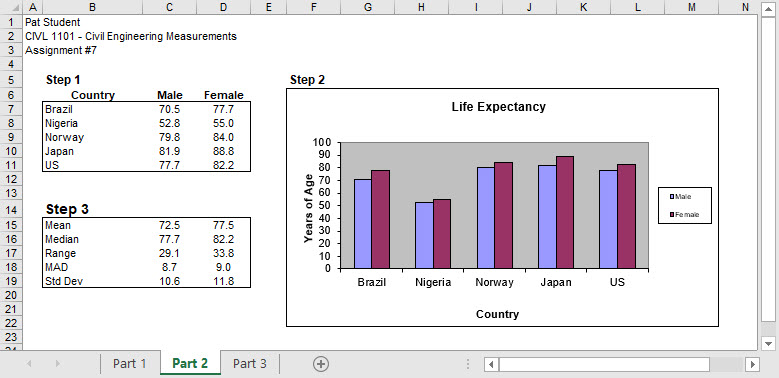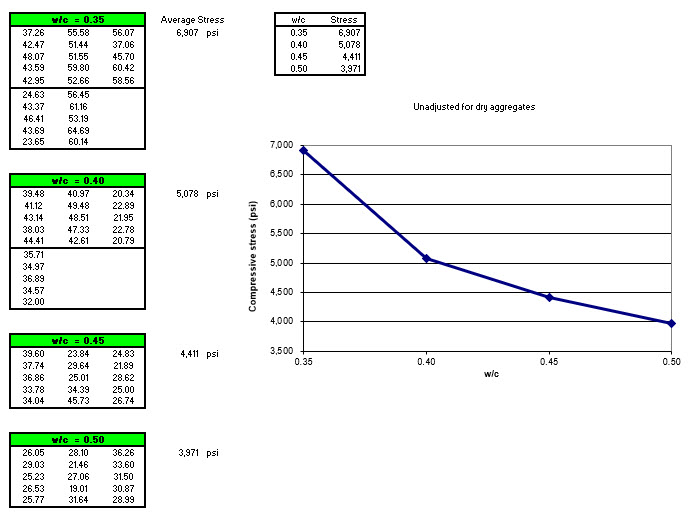|
"The man who knows it all has lots to
learn" - Unknown
Objective
The purpose of this assignment is threefold. First, you will get a chance to
practice your skills in developing simple engineering spreadsheets. Second, you
will be introduced to the graphing and charting capabilities of Excel. And
finally, you get an opportunity to compute you current grade in the class. Submit your Excel file
for Parts 1-3 to the Dropbox in eCourseware. For Part 4, you may develop a
spreadsheet (the preferred method) or compute you current grade by hand on
engineering paper and then upload the file to the Dropbox.
Part 1: There are two basic steps in this part of the
assignment. Step 1 involves accessing information from the internet, Step 2
deals with spreadsheet graphs. The sample output shows the basic spreadsheet
layout you should achieve. Use the data you find on the web.
- This assignment's data can be found on the following web pages:
Top 300 Female First Names or the
Top
300 Male First Names. Write down the top ten first names and their percentages. You
may want to browse through the list for your own name and add it to the top ten.
- Create a spreadsheet table showing the ten (or eleven) first names and their
percentages. The column of names should be left justified
and the column of numeric data (i.e., percentages) and its heading should be center justified. The numbers should appear with a percentage
sign and exactly three digits after the decimal point.
Use the data in your table to construct a bar chart. The chart should have a title
(e.g., Most Common Female Names). The bars should be labeled with the first names. The
vertical axis should show the percentages (any number of digits after the decimal point).
Note, the following sample output.

Part 2: The life expectancy in the United States is
relatively high (78 years for males and 82.5 for females). The life expectancy is significantly
different in other countries. There are three basic steps to Part Two. Step 1 involves
accessing information from the internet, Step 2 deals with spreadsheet graphs, and step 3 involves using the built-in functions of your spreadsheet program. The sample
output shows the basic spreadsheet layout you should achieve. Do not use the data
in the sample output; use the data you find on the web.
- The CIA provides an excellent unclassified
overview of countries
around the world. Examine their information about Brazil,
Nigeria,
Norway,
Japan and one more country of your choice. Write down the male and female life expectancies for
these five countries. Since the individual country data files are fairly large, you may not want to print
them. The life expectancies are listed in the People and Society section of the files
(near the top). You can use your web browser's slider bar or the PgUp and PgDn keys to
move up and down in a file. You can also use the browser's Edit/Find feature to search for
"expectancy."
- Create a spreadsheet table with the life expectancies for the five
countries. The column of country names should be left justified and the two
columns of numeric data and their headings should be center justified.
- Construct a paired bar chart showing the male and female life expectancies.
The chart should have a title (e.g., Life Expectancy). The horizontal axis
must be labeled with the country names (or abbreviations). A legend indicating
gender must also be included. The vertical axis should show the years. As
before, use the data found on the web, not the sample data shown below.
Use the data collected in Step 1 to compute the
mean,
median,
range,
mean absolute deviation and
standard
deviation of the male and female life expectancies. Your statistics should be center justified with two digits after the decimal point. These statistics should be computed by the
spreadsheet program (i.e., not by hand).

Part 3: Develop a graph of the relationship between
compressive failure stress and w/c.
Use the data shown below from the CIVL 1101 lab (mix 1-2-2). Using an x-y scatter plot
your graph should look similar to the one below.

Part 4: Compute your current grade in the
class using the information in the
class syllabus.
Part 5: Read Chapter 7 in the
Strategies for Creative Problem Solving by Fogler and LeBlanc
Coversheet for homework
This website was originally
developed by
Charles Camp for
CIVL
1101.
This site is
Maintained by the
Department of Civil Engineering
at the University of Memphis.
Your comments and questions are welcomed.
|



